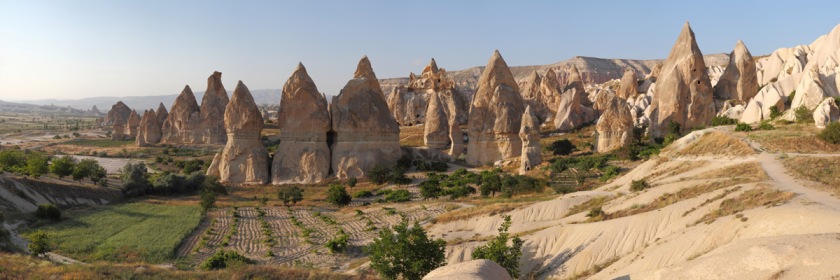
Cappadocia home of the fairy chimneys. Photo: Benh Lieu Song/Wikipedia
When writing his first epistle, the Apostle Peter addresses it to the elect living in Pontus, Galatia, Cappadocia, Asia and Bithynia (1 Peter 1:1). The Apostle’s second letter was also written to these same groups of people (2 Peter 3:1).
But in this list, there is one very strange place — Cappadocia, home of the fairy chimneys.
Located in modern Turkey, the area is composed of a unique landscape made up of a thick layer of tufa, a soft stone made of volcanic ash from nearby volcanoes that mixed with mud and lava.
Because the rock is soft, it is easily sculpted by wind, rain and water run-off forming a bizarre landscape more at home in a science fiction movie than on earth.
With a landscape filled with an estimated 50,000 spires, turrets, cones and pyramids, Cappadocia is Turkey’s most famous tourist attraction. Some, because of their unique caps, have been given the name fairy chimneys. (At the end of the article there is a small slide show of the area.)
Over the centuries people living in Cappadocia have carved out homes in the soft-rock hills, and sometimes inside these fairy chimneys. There are even apartments (one 16 stories high), businesses and castles carved in the rock.
After Rome legalized Christianity in the 4th century, Cappadocia was a haven for churches and monasteries. The remains of hundreds of churches carved in the hillside and larger turrets speak of the large vibrant Christian community that once existed there.
One 14 km gorge, located near the village of Ihlara, has nearly 150 churches.
Some of the earliest groups living in the area also dug below ground. The large caverns, initially created by water runoff, were first excavated by the Hittites to probably hide from invaders. The husband of Bathsheba — the woman King David committed adultery with — was none other than Uriah the Hittite (2 Samuel 11:3).
These caverns were later expanded into extensive underground cities by early Christians to avoid persecution first by the Romans and later by the Muslims who would take over the area.
The biggest underground cities, Kaymakli and Derinkuyu, were built by Christians during the Arab invasions that took place during the 7th and 8th century.
Some of these small cities go down six or seven layers or stories (see slideshow below). They featured chimneys and air vents and included areas for waste and garbage. The Christians lived on the top levels and the lower levels is where they had their businesses such as flour production and wine making and also built their churches.
These underground cities had several protective features including traps, large stones that covered entrances to secret hiding places and holes in the ceiling through which defenders could shoot down arrows or spears on invaders.
So how did Christianity first come to Cappadocia?
We know that region was not visited by the Apostle Paul during his missionary journeys, but Peter’s two letters indicate he had some familiarity with these people and might have visited the area.
There is actually one more mention of this strange land in the New Testament and again it is connected to Peter that possibly supports this theory.
When the Holy Spirit fell on the disciples in the Upper Room on the Day of Pentecost, they poured into the streets speaking in tongues (Acts 2).
It amazed the devoted Jews visiting Jerusalem for the Feast of Shavuot (also called Pentecost) from various parts of the Roman empire when they heard their languages being spoken by the disciples.
Luke actually lists some of these places (Acts 2:9-11) — including three mentioned by Peter at the beginning of his letter — Cappadocia, Pontus and Asia.
When the Apostle Peter preached on the Day of Pentecost, 3,000 people became believers in the Jewish Messiah and this probably included people from Cappadocia, because it would explain why Luke knew where they and the others were from.
After they became Christians, these new Jewish believers returned home.
At some point, Peter may have followed-up with his first converts and visited Cappadocia to strengthen the believers and build the first churches in the area.
Sources:
- The fairy chimneys of Cappadocia: Ferrell’s Travel Blog
- Cappadocia was home to early Christians: Ferrell’s Travel Blog
- Pigeon Valley and Uchisa in Cappadocia: Ferrell’s Travel Blog
- Cavetown and Gorges of Cappadocia: Great Adventures













Remarkable. I was just there 2 weeks ago – and found the experience worshipful as I took every opportunity to sing a-cappella in the many beautiful acoustic cave-churches that bear the marks of our early brothers and sisters in Christ. I tried to imagine what it would’ve been like to worship in a more primitive (that is: not modern) way without concern or attention to amps and sound systems. While there, I managed to finished Greek Orthodox theologian John Zizioulas’ fine book “Being as Communion” – where he writes about the Cappadocian father’s who so profoundly protected and articulated the gospel handed from Peter centuries earlier. Here was my most recent post regarding Turkey – though not in this theme: https://moreenigma.wordpress.com/2016/03/19/there-but-for-the-grace-of-god-go-i/
LikeLike
Thanks for your comment Rusty. I appreciated your first hand account of this area. Also enjoyed your article on your visit to Turkey.
LikeLike